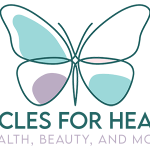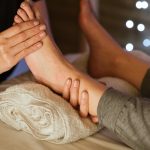
In today’s fast-paced, stress-filled world, more people are turning to holistic practices to find balance and maintain their health. One such method, reflexology, has gained popularity for its ability to support natural healing processes and provide relief for a wide range of modern health challenges. While it’s not a new concept—reflexology has ancient roots—it remains highly relevant today. In this blog, we’ll explore what reflexology is, how it works, and how it can be used to address common health issues in modern society.
What is Reflexology?
Reflexology is a therapeutic practice based on the belief that certain areas of the feet, hands, and ears correspond to different organs and systems within the body. By applying pressure to these specific points, known as reflex points, practitioners aim to stimulate the body’s natural healing processes. Reflexology is often used as a complementary therapy, working alongside conventional medical treatments to promote overall wellness.
The practice is deeply rooted in ancient healing traditions. Early forms of reflexology can be traced back to ancient Egypt, China, and India, where healers used similar techniques to restore balance and well-being. Over time, reflexology evolved into a more structured practice, and today it’s recognized as a holistic therapy that supports both physical and emotional health.
The Science Behind Reflexology
Reflexology operates on the principle that energy pathways—often referred to as “meridians” in traditional Chinese medicine—run throughout the body. Blockages in these energy pathways can lead to illness, discomfort, and imbalance. By applying pressure to specific reflex points, reflexologists aim to clear these blockages and restore the smooth flow of energy, allowing the body to heal naturally.
While reflexology is often described in energetic terms, scientific research has also explored its physiological effects. Studies have shown that reflexology can stimulate the nervous system, enhance circulation, reduce stress, and promote relaxation. The connection between the reflex points and the corresponding organs or systems is thought to occur through nerve impulses, which trigger the body’s natural healing responses.
Reflexology in Modern Healthcare
In today’s world, people are increasingly looking for natural and non-invasive ways to address health concerns. Reflexology offers a holistic approach that complements modern medicine, helping individuals manage everything from chronic pain to emotional stress.
Here are some of the most common modern health challenges that reflexology can help address:
- Stress and Anxiety
Modern life is filled with stressors—from demanding jobs to busy family schedules. Chronic stress not only takes a toll on mental well-being but also contributes to physical health issues such as high blood pressure, digestive problems, and weakened immune function. Reflexology is a powerful tool for stress relief because it promotes relaxation, calms the nervous system, and helps restore emotional balance. By stimulating reflex points related to the brain, adrenal glands, and heart, reflexologists can help reduce the body’s stress response. - Chronic Pain
Whether caused by injuries, arthritis, or long-term conditions like fibromyalgia, chronic pain is a growing issue in modern healthcare. Reflexology offers a non-invasive, drug-free method for managing pain by targeting reflex points that correspond to specific areas of discomfort. For instance, pressure on the reflex points of the feet can help relieve lower back pain, while points on the hands may address tension in the neck and shoulders. Many individuals report feeling significant pain relief and an improvement in mobility after regular reflexology sessions. - Digestive Disorders
Poor diet, lack of exercise, and stress can all contribute to digestive issues such as bloating, irritable bowel syndrome (IBS), and constipation. Reflexology can aid digestion by stimulating reflex points connected to the stomach, intestines, and liver. This promotes better digestion, increases nutrient absorption, and encourages regular bowel movements. By improving digestive health, reflexology can also help alleviate symptoms like heartburn, gas, and cramping. - Insomnia and Sleep Disorders
Sleep is vital for health, but many people struggle with insomnia or poor sleep quality. Reflexology is known for its ability to promote deep relaxation, which is essential for falling and staying asleep. Reflexologists focus on reflex points that correspond to the nervous and endocrine systems to help regulate the body’s natural sleep-wake cycle. A reflexology session before bed can calm the mind and body, making it easier to unwind and enjoy a restful night’s sleep. - Hormonal Imbalances
Hormonal imbalances can manifest as irregular menstrual cycles, menopausal symptoms, thyroid disorders, or issues with fertility. Reflexology can support the endocrine system, which controls the body’s hormones, helping to restore balance and alleviate symptoms. Reflex points connected to the pituitary, adrenal, and reproductive organs are often targeted to encourage proper hormonal function. Many women find reflexology beneficial for managing PMS, menopausal symptoms, and even fertility issues. - Immune System Support
A strong immune system is crucial for fighting off illnesses, especially in today’s world where people are constantly exposed to environmental toxins, stress, and infectious diseases. Reflexology can help boost the immune system by stimulating reflex points that correspond to the lymphatic system, spleen, and thymus. By promoting better circulation and encouraging the removal of toxins, reflexology strengthens the body’s natural defenses against illness.
The Reflexology Process
Reflexology sessions typically begin with a consultation to assess the client’s health concerns and determine which reflex points need to be targeted. The client then sits or lies down in a relaxed position while the reflexologist uses their fingers, thumbs, and sometimes tools to apply pressure to specific areas of the feet, hands, or ears. Each session usually lasts between 30 to 60 minutes.
Reflexologists often use a map of the body’s reflex points, with each part of the body corresponding to a particular area on the foot, hand, or ear. For example, the toes represent the head and neck, while the arch of the foot is linked to the digestive organs. By methodically working through these reflex points, the reflexologist can stimulate the body’s natural healing processes.
Is Reflexology Right for You?
One of the most appealing aspects of reflexology is that it is suitable for people of all ages and health conditions. Whether you’re dealing with chronic health issues or simply looking to maintain your well-being, reflexology can be an excellent addition to your health regimen. However, it’s essential to remember that reflexology should not be used as a substitute for medical care, especially for serious conditions. Always consult your healthcare provider before starting any new therapy.
Reflexology is generally considered safe when performed by a qualified practitioner, but it may not be appropriate for individuals with certain conditions such as foot injuries, blood clots, or infections. Pregnant women should also consult with their healthcare provider before receiving reflexology treatments.
The Future of Reflexology
As more people seek out natural and holistic approaches to health, reflexology is likely to continue growing in popularity. Advances in research are helping to further validate its effectiveness, and more healthcare providers are beginning to incorporate reflexology into their treatment plans. Reflexology’s non-invasive nature, combined with its ability to address both physical and emotional health, makes it an appealing option for those looking for a more comprehensive approach to wellness.
In the future, we may see reflexology used more widely in integrative health settings, where conventional medical treatments are combined with complementary therapies. Hospitals and wellness centers are increasingly offering reflexology to patients as a way to manage pain, reduce stress, and improve overall well-being.
Conclusion
Reflexology is an ancient practice that has stood the test of time, and its ability to address modern health challenges makes it as relevant today as it was thousands of years ago. Whether you’re struggling with chronic pain, stress, or digestive issues, reflexology offers a natural, non-invasive way to promote healing and restore balance. By tapping into the body’s innate healing power, reflexology helps people navigate the health challenges of today with grace and resilience.
If you’re interested in exploring reflexology for your health concerns, seek out a qualified practitioner who can guide you on your journey to natural healing. Reflexology may just be the ancient solution you need for modern-day wellness.


